In their column, entitled "Innovation's Accidental Enemies", authors Roger L. Martin and Jennifer Riel , academics at the Rotman School of Management at the University of Toronto , posit that too many executives manage when they should lead: to wit, they rely too often on inductive and deductive reasoning. They fail to embrace abductive reasoning when confronted with a never-done-before idea for project excecution. In doing so, they become the accidental enemy of a radically new idea.
What, say you, is abductive reasoning? It's the third leg of inductive, deductive, and abductive reasoning. One only needs to search a bit in Wikipedia to get the ideas.
Inductive and deductive reasoning aligns rules and data--either one or the other begets the other--a traditional manager's view of putting the enterprise's rules with the situational facts. Nothing wrong with that---some of my best friends are inductive or deductive reasoners--but even though one or the other works well in many situations, they don't always work when innovation is the order of the day.
Innovative ideas many times do not comport with established rules. That lets out deductive reasoning. Innovative concepts are often free of facts and seemingly lack cohesion and coherence among the available data. That lets out inductive reasoning.
Abduction is reasoning through, or postulating, or hypothesizing that seeming unrelated facts or ideas indeed do connect. Haven't we heard endlessly about connecting the dots? Well, having a skill, and a tolerance, for the emergence of a new idea by abductive reasoning is key to having visionary foresight.
The genius of innovators is not to let their management impulses overwhelm their instincts to inspire, motivate, and empower.
Recall this witicism from Rear Admiral Grace Hopper [esteemed software leader who, among other things, invented the 'bug']: "Things are managed; people are led"
Are you on LinkedIn?  Share this article with your network by clicking on the link.
Share this article with your network by clicking on the link.
 Share this article with your network by clicking on the link.
Share this article with your network by clicking on the link. 








